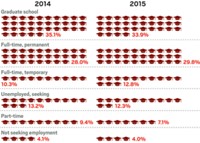Advertisement
Grab your lab coat. Let's get started
Welcome!
Welcome!
Create an account below to get 6 C&EN articles per month, receive newsletters and more - all free.
It seems this is your first time logging in online. Please enter the following information to continue.
As an ACS member you automatically get access to this site. All we need is few more details to create your reading experience.
Not you? Sign in with a different account.
Not you? Sign in with a different account.
ERROR 1
ERROR 1
ERROR 2
ERROR 2
ERROR 2
ERROR 2
ERROR 2
Password and Confirm password must match.
If you have an ACS member number, please enter it here so we can link this account to your membership. (optional)
ERROR 2
ACS values your privacy. By submitting your information, you are gaining access to C&EN and subscribing to our weekly newsletter. We use the information you provide to make your reading experience better, and we will never sell your data to third party members.
Salaries
Who Are The American Chemical Society’s Members, And What Do They Earn?
The 30th anniversary of a comprehensive salary survey shows what has changed—and what hasn't—about ACS members
by Andrea Widener , Linda Wang
November 8, 2015
| A version of this story appeared in
Volume 93, Issue 44
Think back to 1985. Michael Jordan was NBA Rookie of the Year. Microsoft released its first version of Windows. “Back to the Future” was one of the top movies. Gas cost an average of $1.09 per gal.
The year 1985 was also when the American Chemical Society started its ChemCensus. Although ACS does a smaller salary survey every year, ChemCensus is a comprehensive look at ACS members’ demographics and earnings that’s conducted every five years. That means it offers the most reliable data on the makeup of ACS—way more accurate than time travel via DeLorean.
To mark the 30th anniversary of ChemCensus, C&EN explored what ACS’s membership looked like in 1985 compared with 2015. We interviewed two members who got their Ph.D.s in those years to get their perspective on how the job market has changed (see page 32). We also present some of our top job advice from today’s members (see page 33).
As the data show, the situation is not all roses for chemists. Salaries are up in real dollars, but if you take inflation into account, they have barely budged in 30 years. Unemployment is up from 1.7% in 1985 to 3.1% this year, which is high for chemists but still below the national average unemployment rate.
Still, there are bright spots, no matter how small. Diversity of ACS members by both race and sex is increasing. For example, women now make up more than 30% of members, double their representation 30 years ago. There are more African American, Hispanic, and Asian members, too.
Sift through the data, and decide for yourself what the future might hold for the chemistry profession.





Join the conversation
Contact the reporter
Submit a Letter to the Editor for publication
Engage with us on Twitter